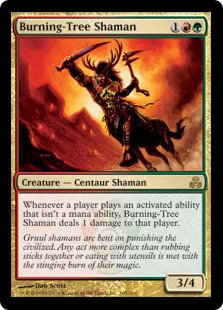Editor’s Note: We’re off today in celebration of the holidays. In the meantime, enjoy this thematically color-appropriate Monday Magic article, which was originally published on 5/19/14.
There are numerous metaphors players use when describing the process of building, running, and maintaining a Magic deck, illustrating the wide spectrum of how people approach all of the game’s various creative aspects:
Decks are a player’s canvas, allowing them to showcase a deck that properly expresses their personal flavor…
Decks are a business, with players insisting on keeping the most productive and efficient pieces of a system while discarding the rest…
Decks are a machine, where you are constantly tinkering to keep it running by improving worn out parts, and ultimately trying to avoid regular misfires…
Decks are a blood sport, forcing players to bring with them only the most lethal tools into battle in order to come out alive on the other side…
Regardless of which adage you subscribe to, at the core of every philosophy is the idea that the decks you craft (unlike, say, netdecking) are truly yours. Ask two players to build an Elf deck, for example, and you’ll get two very different results. This individual tailoring – especially on the casual level – is a major part of Magic’s staying power. It’s a given that the game continues to change and evolve, as do the people playing it. Yet for all of that growth and change, it’s impossible for a casual player to have decks without their own person stamp on them. This is hardly a negative thing. Actually, it’s quite the opposite.
Commander is no different. In fact, with larger decks and more one-off card choices, it’s hard even for the most stringent of min / max types to not inject some kind of personal touch.
How you do that, of course, is up to you. Lots of card draw? Constant board wipes? A plague of Insects? Anything goes.
One such approach are multifaceted utility cards. Because betting on blindly drawing the single card or two you need is difficult with a Commander deck, the more choices cards can provide you, the more prepared you’ll be. Indeed, having a heavy dose of utility cards with a wide variety of abilities keep you prepared for just about anything your opponents can throw at you.
That said, if you’re playing against that sort of deck – where the contingencies have contingencies – it can be really annoying.
So, let’s tip the scales a bit. If you’ve had to deal with this sort of Commander style before, here’s something you can throw into their way.
Today we have: Burning-Tree Shaman

Name: Burning-Tree Shaman
Edition: Guildpact
Rarity: Rare
Focus: Damage Dealing
Highlights: Burning-Tree Shaman doesn’t inherently strike fear into the heart of most players, but that actually works to your advantage. This creature has a potent but passive effect, ensuring that it’ll likely stick around on the board longer than if it was being more punishing. This is because of three key features:
First, Burning-Tree Shaman doesn’t affect a player’s mana base, which saves this centaur from immediate death. (Throw a Manabarbs out and see how beloved you become by contrast.)
Second, it affects everyone, including you. Even if you mitigate its effect, just the simple fact that it is universally punishing significantly downplays swift and immediate retaliation. (Unlike, say, Telepathy.)
Third, the Burning-Tree Shaman only dishes out one damage increments, and players in a Commander game are willing to be stung multiple times if it’s not as obvious they’re being slowly pinged to death. It’s sort of like Extort: a single extort trigger here and there won’t raise any alarms, but when you do it every time you cast a spell, then the klaxons start blaring.
Admittedly, Burning-Tree Shaman won’t win you games by itself, but it makes a great tool in the arsenal all the same by either stopping heavy utility card usage entirely, being a partial deterrent, or softening players up who willfully dismiss this Gruul citizen. How much damage it deals is partially on the players themselves, since you can’t easily force your opponent to activate abilities. Moreover, it can be useful during any course of the game. Casting it early on could delay players ramping up too quickly, and if dropped later it on could inflict significant harm on someone with a lot of board space.
Not to mention, a 3/4 for three mana is nothing to scoff at either, making it a solid creature on top of it all.
Now how’s that for style?
Keep an eye out for us to be regularly featuring other more accessible-but-worth-it Commander cards going forward. In the meantime, we’ll keep the light on for you.
![]()
You can discuss this article over on our social media!
Do you have a particular Commander card to suggest for us to shine a future Spotlight on? You can send suggestions to ryan@cardboardrepublic.com
